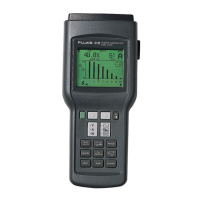Theory of Operation
Circuit Descriptions
2
2-9
Table 2-1. Voltage Gains
Range Signal Gain Software Limit
256V X4 (low) Four 200V peak
512V X2 (low) Two 500V peak
1024V X1 (low) One 937V peak
Table 2-2. Current Gains
Range
Control Signals
Gain Software
X1A X10A X1B X10B
Limit
20A peak 1 0 1 0 100 20A peak
200A peak 1 0 0 1 10 200A peak
2000A peak 0 1 0 1 1 2000A peak
2-22. Anti-Alias Filter
There are two anti-aliasing filters: one for volts (U16) and the other for amps (U17). The
anti alias filter consists of both sections of U16 or U17 and the resistors and capacitors
that are connected to them. The purpose of the filter is to attenuate any input frequencies
that are near or above one half of the sample rate of the a/d converters. The filter is a
4-pole Butterworth, consisting of a cascade of two second-order low-pass filters. The
filter has unity gain from DC to 2.015 kHz (±0.2 dB). The 3 dB point of the filter is at
3.5 kHz. The filter should have ≈19 dB (± 0.5 dB) of attenuation at 6 kHz.
2-23. Level Shifter
Z8 translates the input signal from a bipolar signal, with full scale range of ±2 volts
peak, to an unipolar signal that goes from 0 to 2 volts. The output of the divider should
be at one half of VREF when the input is at zero volts. The resistors in Z8 are ratio
matched to 0.1%, with the resistor between pins 1 and 8 as the reference.
2-24. A/D Converters
The two a/d converters are 10-bit successive approximation converters. One measures
volts and the other measures amps. These parts use serial interfaces to communicate to
the DSP through U3’s serial Multiplexer section. When CS_AD* goes low, the a/d
converter starts a conversion cycle. CS_AD* stays low during each conversion cycle.
During the conversion cycle, 12 bits are read by the microcontroller. The a/d converter
sends the two Least Significant Bits twice. The data is sent Most Significant Bit first.
The a/d converter sample rate is 10.076 kHz and the clock rate is 241.824 kHz. Resistor
R71 is needed to limit the current between the a/d converter and the microcontroller
because the a/d converter operates at 5 volts, while the microcontroller operates at 3.3
volts.

